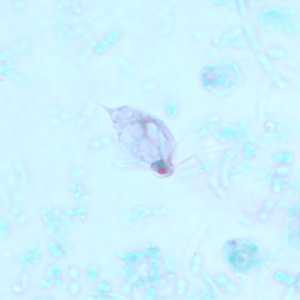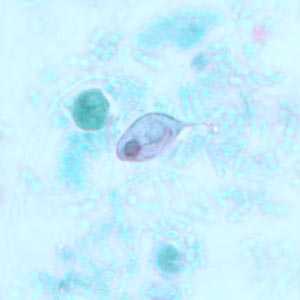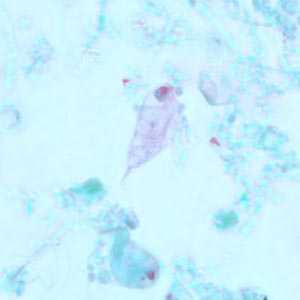
Case #239 - November, 2008
A 50-year-old man went to his health care provider after a week of intermittent diarrhea, cramps and nausea. Stool specimens were collected over three consecutive days and sent to the local public health laboratory for routine ova and parasite (O&P) work-up. Figures A–C show objects observed at 1000x magnification on a trichrome-stained slide prepared from the stool specimens. The objects measured approximately 12 micrometers in length. What is your diagnosis? Based on what criteria?

Figure A

Figure B

Figure C
Case Answer
The objects observed in this case were trophozoites of the flagellate, Chilomastix mesnili (although flagella may not be visible in stained specimens). Even though C. mesnili is considered nonpathogenic, it should be reported in all routine O&P testing. The presence of C. mesnili in stool specimens could indicate fecal contamination of a food or water source and be an indicator for the presence of other pathogens. The diagnostic features for C. mesnili included:
- trophozoites within the size range (6-24 µm long) of the species, possessing a thicker anterior end and a posterior end tapering to a point.
- a single nucleus containing a large, eccentric karyosome, located at the anterior end of the trophozoites.
More on: Chilomastix mesnili
Images presented in the monthly case studies are from specimens submitted for diagnosis or archiving. On rare occasions, clinical histories given may be partly fictitious.
DPDx is an education resource designed for health professionals and laboratory scientists. For an overview including prevention and control visit www.cdc.gov/parasites/.
- Page last reviewed: August 24, 2016
- Page last updated: August 24, 2016
- Content source:
- Global Health – Division of Parasitic Diseases and Malaria
- Notice: Linking to a non-federal site does not constitute an endorsement by HHS, CDC or any of its employees of the sponsors or the information and products presented on the site.
- Maintained By:


 ShareCompartir
ShareCompartir